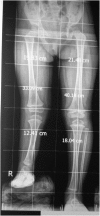Ankle Reconstruction in Fibular Hemimelia: New Approach
- PMID: 28690469
- PMCID: PMC5481255
- DOI: 10.1007/s11420-016-9524-6
Ankle Reconstruction in Fibular Hemimelia: New Approach
Abstract
Background: Fibular hemimelia is a congenital disorder that is characterized by the absence of the fibula that could be either partial or complete. Successful management aims to restore normal weight bearing and normal limb length. The introduction of the Ilizarov method of limb lengthening has provided an attractive alternative to amputation. During lengthening, the tight posterolateral soft-tissue structures, the thick fibrous fibular band, and the shortened Achilles tendon become tighter and transfer a valgus force to the talus and calcaneus, further aggravating the deformity.
Questions/purposes: We have developed a strategy to address this in patients with Paley type III fibular hemimelia via ankle reconstruction that provides posterolateral stability and buttressing of the ankle and hind foot by reconstructing the lateral buttress. This is achieved through excision of the fibrous fibular anlage, centralization of the ankle, restoring talocalcaneal coronal alignment, and reconstruction of the lateral malleolus by transplanting the cartilaginous remnant of the lateral malleolus or by crafting a bone block autograft taken from the iliac crest or tibia.
Methods: A prospective non-randomized clinical trial included ten ankles in eight patients with fibular hemimelia Paley type III (two patients had bilateral deformity). The patients' ages ranged from 7 to 36 months.
Results: After a follow-up ranging from 48 to 96 months, a stable plantigrade foot was achieved in nine ankles; one ankle had residual equinus, five ankles had residual valgus heel, and eight ankles had complete range of motion of the ankle, whereas one patient lost 5° of dorsiflexion. One ankle had equinus deformity.
Conclusions: To achieve satisfactory results, a stable plantigrade foot and ankle is necessary in patients with fibular hemimelia before attempting to equalize limb length discrepancy. It is important to reconstruct the ankle through an extra-articular soft tissue release, anlage resection, osteotomies, and restoring the abnormal talocalcaneal relationship before any attempt to equalize LLD.
Keywords: ankle reconstruction; fibular hemimelia.
Conflict of interest statement
Conflict of Interest:
Hany Hefny, MD; ElHussein M. Elmoatasem, MD; Mahmoud Mahran, MD, MRCS; Tamer Fayyad, MD; Mohamed A. Elgebeily, MD; Ahmed Mansour, MD; and Mamdouh Hefny have declared that they have no conflict of interest.
Human/Animal Rights:
All procedures followed were in accordance with the ethical standards of the responsible committee on human experimentation (institutional and national) and with the Helsinki Declaration of 1975, as revised in 2008 (5).
Informed Consent:
Informed consent was obtained from all patients for being included in the study.
Required Author Forms
Disclosure forms provided by the authorsare available with the online version of this article.
Figures














References
-
- Achterman C, Kalamchi A. Congenital deficiency of the fibula. J Bone Joint Surg (Br) 1979;61:133–137. - PubMed
-
- Bohne WH, Root L. Hypoplasia of the fibula. Clin Orthop Relat Res. 1977;125:107–112. - PubMed
-
- Catagni MA, Guerreschi F. Management of fibular hemimelia using the Ilizarov method. In: Herring JA, Birch JG, editors. The child with a limb deficiency. Rosemont: American Academy of Orthopaedic Surgeons; 1998. pp. 179–193.
LinkOut - more resources
Full Text Sources
Other Literature Sources

